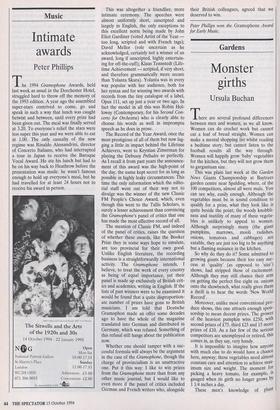Gardens
Monster girths
Ursula Buchan
There are several profound differences between men and women, as we all know. Women can do crochet work but cannot cut a loaf of bread straight. Women can make a mental shopping list whilst reading a bedtime story, but cannot listen to the football results all the way through. Women will happily grow 'baby' vegetables for the kitchen, but they will not grow them to gargantuan size.
This was plain last week at the Garden News Giants Championship at Baytrees garden centre near Spalding, where, of the 100 competitors, almost all were male. You can see why, easily enough. Although the vegetables must be in sound condition to qualify for a prize, what they look like is quite beside the point; the woody knobbli- ness and inutility of many of these vegeta- bles is unlikely to appeal to women. Although surprisingly many (the giant pumpkins, marrows, mooli radishes, onions, tomatoes and cabbages) are eatable, they are just too big to be anything but a flaming nuisance in the kitchen.
So why do they do it? Some admitted to growing giants because their too easy suc- cess at 'quality' (as opposed to 'size') shows, had stripped these of excitement. Although they may still chance their arm on getting the perfect five eight oz. onions onto the showbench, what really gives them a thrill is to hear the words 'New World Record'.
Moreover, unlike most conventional pro- duce shows, this one attracts enough spon- sorship to mean decent prizes. The grower of the heaviest pumpkin wins £250, with second prizes of £75, third £25 and 15 more prizes of 110. As a fair few of the serious competitors are unemployed or retired, this comes in, as they say, very handy.
It is impossible to imagine how anyone with much else to do would have a chance here, anyway; these vegetables need almost constant care and attention to achieve max' imum size and weight. The moment for picking a heavy tomato, for example, is gauged when its girth no longer grows by 11/4 inches a day. These men's knowledge of plant physiology is impressive. As money is often tight, they depend heavily on manures and home-made concoctions to feed the vegeta- bles, preferring to use any cash on polythene tunnels, grow lights (for onions) and plastic guttering, in which they can grow vegetables for the longest parsnip or carrot classes. (These two classes are a bit of a chizz; most of the vegetable's length comes from strand-like fibrous, rather than `edible', roots.) Generally speaking, there are no magic formulae; most amateur gar- deners could not grow monsters if they tried, because their soil is not cultivated and fertilised to anywhere near its full potential, and, of course, they are not pre- pared to leave the vegetables in the ground all summer.
Stories have always circulated about how some growers 'bend the rules', for example, by inflating marrows, using a sugar and water solution, drawn up by cotton wool wick attached to the stalk. I was told in no uncertain terms that this is not done, mainly because it does not work, but the chief safe- guard against cheating is that most judges have also in the past been exhibitors. This was not a year for breaking world records. A wet, cold spring, followed by high temperatures in July, inhibited growth at crucial times. But Ian Neale of Newport, a market gardener, managed it with the heaviest beetroot. A 40 lb 8 oz. beetroot is scarcely recognisable as such, being almost square and as warty as an old toad. It is a good thing that it is uneatable because it must be replanted after the competition, to flower and set seed; this is then sown, or given away to best mates. These growers set great store by the strain of seed. Genealogy matters as much to them as to a duke's second cousin. Bernard Lavery, who holds the world record for a pumpkin (710 lbs) and who acted as impresario and compere to this entertainment, has turned his capabilities to commercial advantage, founding a seed club and selling seed of giants for £2 a packet. He is keen to emphasise the fun of it all. Pumpkins certainly make me laugh because they resemble recently vacated bean bags, but much of the rest is too grotesque to be funny. There is certainly nothing laughable about the growers. Contrary to popular myth, they are not wild-eyed obsessives. Richard Hope of Wigan, for example, who Produced both a 74 lb marrow and a 15 lb cucumber, is a smiling, softly spoken, crag- gy version of Will Carling, who looks very much at peace with himself. Easy to spot in the crowd, because of their crinkly-eyed, sunburnt faces and home-knitted jerseys, the showmen could not be seen even exchanging a cross word, let alone indulging in an unseemly row. They may be competitors but they know they are part of the freemasonry of giant veg. growers, whom the world — or that part of it which is female, at least — simply does not understand.



























































 Previous page
Previous page